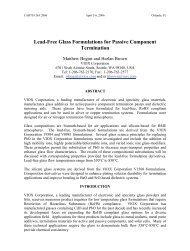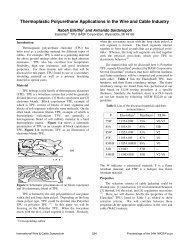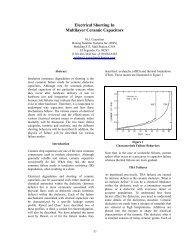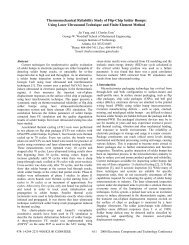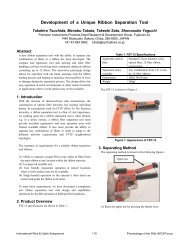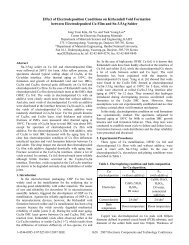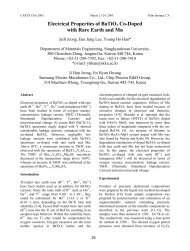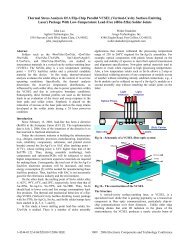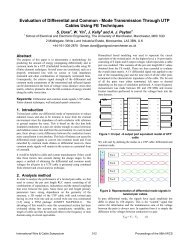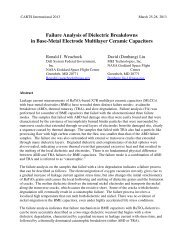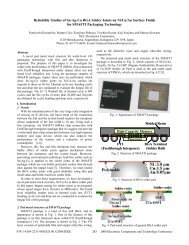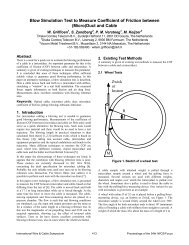Dielectric Aluminum Oxides: Nano-Structural Features and ...
Dielectric Aluminum Oxides: Nano-Structural Features and ...
Dielectric Aluminum Oxides: Nano-Structural Features and ...
You also want an ePaper? Increase the reach of your titles
YUMPU automatically turns print PDFs into web optimized ePapers that Google loves.
<strong>Dielectric</strong> <strong>Aluminum</strong> <strong>Oxides</strong>: <strong>Nano</strong>-<strong>Structural</strong> <strong>Features</strong> <strong>and</strong><br />
Composites<br />
J.L. Stevens 1 , A.C. Geiculescu 2 , T.F. Strange 2<br />
1 Technology Partners, s.p. 2820 Kennerly Rd., Irmo, SC 29063 PH: 1-803-781-3972<br />
jstevens@tec-partner.com or jlstevens@sjm.com<br />
2 St. Jude Medical, Inc. – CRMD 253 Financial Blvd., Liberty, SC 29657 PH: 1-864-843-<br />
8200<br />
cgeiculescu@sjm.com or tstrange@sjm.com<br />
INTRODUCTION<br />
Barrier layer aluminum oxide dielectrics formed in aqueous solutions can be produced in<br />
either an amorphous or a crystalline form by numerous processes 1-4 which have been<br />
reported upon over the last 100 years. Generally, the amorphous oxide variety yields higher<br />
physical stability <strong>and</strong> lower leakage current <strong>and</strong> dissipation at the cost of 40% lower<br />
capacitance than crystalline alumina. The crystalline variety therefore is sought in all<br />
applications except those requiring the highest oxide quality. Over the last 40 or 50 years,<br />
much effort has been expended to close the gap in stability between these two oxide types<br />
while maximizing the capacitance obtained.<br />
The authors have developed a nano-composite dielectric aluminum oxide which combines<br />
amorphous oxide’s extreme oxide stability toward the st<strong>and</strong>ard boiling water test with most<br />
of the capacitance of crystalline alumina. This oxide possesses a number of unique nanostructural<br />
characteristics which have been studied <strong>and</strong> are believed to contribute to this blend<br />
of high boiling water test stability <strong>and</strong> high capacitance.<br />
As an extension of work 7 reported earlier, further study of the amorphous oxide produced in<br />
an ethylene glycol forming environment, such as occurs at cut edges during the traditional<br />
aging process, has led to the discovery of new nano-structural features there as well. These<br />
structures are shown to depend upon process variables <strong>and</strong> seem to have their origins in the<br />
nano-environment present at the oxide surface during their production.<br />
EXPERIMENTAL<br />
Any capacitors tested consisted of st<strong>and</strong>ard production ICD capacitor stacks made with<br />
specially prepared anodes. First charge rise time measurements were performed with a<br />
Keithley Model 237 HV Source/Measurement Unit <strong>and</strong> a Keithley Model 2001 DMM. ICD<br />
capacitors were charged at a rate of 5mA while foil coupons were charged at a rate of 20<br />
uA/cm 2 . Anode foil coupons were made from very high gain etched, 99.98%+ purity<br />
aluminum anode foil sheets each measuring approximately 1 uF/cm 2 after being formed to a<br />
voltage of 475 volts as 10 cm 2 coupons on a laboratory formation robot. Studies on<br />
formation/aging of raw, cut edges on plain 99.99% formed aluminum tabstrips were done as<br />
a scintillation voltage test by application of 1.25 mA/cm 2 at 37C in an ethylene glycol<br />
electrolyte containing boric acid <strong>and</strong> azelaic acid salts.<br />
63
The surfaces of various films on Al substrates were observed with a Hitachi FE-4800. An<br />
electron beam with 1.5 keV acceleration voltage <strong>and</strong> 7-10 µA current was used for imaging.<br />
Working distance was kept at ~ 1.5 mm while both SE detectors were mixed for better detail.<br />
Prior to the FE-SEM analysis, all films were coated with a 2 nm Pt/Pd layer from a 208<br />
HR/MTM20 Cressington Sputter unit.<br />
Specimens to be examined by TEM were thinned using a Hitachi FB2000A focused ion<br />
beam (FIB). A beam of Ga ions radiating parallel to the plane of the sample face was used to<br />
cut sections of ~ 50 nm thickness. These thin sections of the oxide films on Al substrate were<br />
examined with a Hitachi HD-2300 TEM. A beam with 200 kV acceleration voltage <strong>and</strong> 20-<br />
30 µA current was used for imaging. Electron diffraction patterns were generated using a<br />
beam diameter of 200-300 nm at 200 kV <strong>and</strong> 80-85 nA current.<br />
Stability Testing was accomplished by using a ramp-build-time test in 85 °C citric acid<br />
solution with 0.5 mA/cm2 current density after boiling for two hours in deionized (DI)-<br />
water. The rise times to 95% of V f were measured <strong>and</strong> used to assess the stability of the<br />
grown oxides, <strong>and</strong>, in turn, the level of defects/voids exposed by boiling.<br />
Anodization of Etched Foil:<br />
RESULTS<br />
One of the accepted methods of producing amorphous aluminum oxide for high voltage use<br />
involves initially anodizing the etched foil at low temperature in an oxidizing acid such as<br />
sulfuric acid to deposit a thick amorphous, porous layer of alumina inside the etch structure.<br />
Figures 1 <strong>and</strong> 2 show a plan view <strong>and</strong> a cross-sectional view of such porous oxides inside of<br />
etch tunnels. While this oxide has little in the way of barrier properties, it serves as the base<br />
layer for a formation step which fills in the pores with additional amorphous oxide to leave a<br />
barrier layer of the desired forming voltage. This oxide has the ability to withst<strong>and</strong> high<br />
duty cycles of charge – discharge with minimal increases in leakage current <strong>and</strong> dissipation<br />
factor. Unfortunately, amorphous oxide has a higher dielectric ratio [~1.4 nm/V] as<br />
compared to crystalline aluminum oxide [~1.0nm/V] which leads to 40% lower capacitance.<br />
The disadvantage of crystalline oxide is the presence of appreciable tensile stress which may<br />
lead to relaxation <strong>and</strong> cracking when subjected to thermal, chemical, electrical or mechanical<br />
stressors. The 40% capacitance advantage of crystalline oxide explains why so much work<br />
has gone into stabilization of the crystalline oxide on capacitor foils.<br />
64
Figure 1.Interior Surface SEM: Anodized Etched Foil Tunnel With Pores of ~10nm<br />
Diameter.<br />
Figure 2. Tunnel Cross-sections: Anodized Etched Foil Oxide With Pores of ~10nm<br />
Diameter.<br />
65
St<strong>and</strong>ard Crystalline Etched <strong>and</strong> Formed Foil:<br />
Figure 3 shows a “ramp” build curve of a high stability crystalline oxide on etched foil after<br />
being subjected to a 2 hour boil stress test. To obtain this “ramp” curve, the foil was<br />
immersed in 500 uS/cm citric acid at 85C followed by application of 0.5mA/cm 2 to grow<br />
new oxide in any damaged areas. The graph shows a plot of the required charge/V to repair<br />
any damage as the voltage builds up to the original forming voltage. Therefore the curve<br />
serves as a probe of the degree of cracking or other damage as a function of the distance in<br />
volts from the metal surface [with an indeterminate offset due to numerous series<br />
resistances]. We see that there is a large amount of damage repair deep within the barrier<br />
layer followed by a relatively smaller amount of repair in the 200V to 450V range. Work by<br />
Uchi 5 , Kanno, <strong>and</strong> Alwitt as well as by Stevens 6 <strong>and</strong> Shaffer <strong>and</strong> others has shown that this<br />
damage is due to cracking <strong>and</strong> delamination of the oxide plus some exposure of voids found<br />
in the upper half of the crystalline oxide layer. While the damage appears severe in this<br />
typical ICD foil curve, the rise time was 20.4 seconds as compared to world-class<br />
commercial foils with crystalline alumina dielectrics which typically exhibit rise times of 40<br />
to 80 seconds. Nevertheless, such tiny residual stresses have small, but finite, probabilities<br />
of relaxing in the capacitor <strong>and</strong> producing longer charge times <strong>and</strong> higher leakage currents<br />
until the damage is repaired.<br />
Figure 3.: 2 Hour Boil Test “Ramp” Curve: High Stability Oxide on ICD-Style Etched<br />
Foil. Rise Time = 20.4 sec.<br />
The reason for the residual tensile stress in crystalline anodic oxide is believed to be<br />
associated with the lattice shrinkage that occurs when the pseudoboehmite produced during<br />
hydration of the etched foil is electrolytically converted to gamma´ alumina. Figure 4 shows<br />
a cross-section of a formed etch tunnel in ICD foil with residual hydrate in the tunnel<br />
interior. The textured crystalline barrier alumina is found on the tunnel surface next to the<br />
smooth aluminum metal shown on the left side of the photo.<br />
66
Figure 4. Cross-Section View of Etch Tunnel in ICD Foil With Hydrate Present on<br />
Tunnel Interior.<br />
The textured appearance of the crystalline oxide is due to the nano-crystals produced when<br />
the initial hydrate layer is electrolytically converted to barrier oxide. The residual stress is<br />
believed to exist primarily between these nano-crystals. Normal formation processes use<br />
multiple relaxation [depolarization or degassing] steps plus reformation to relax this stress<br />
<strong>and</strong> repair the damage prior to capacitor assembly. Unfortunately, it is usually not possible<br />
to completely remove all the stress with a finite number of reformation steps.<br />
<strong>Nano</strong>-Composite Etched <strong>and</strong> Formed Foil:<br />
Anodization is known to lead to compressive stress in the porous oxide like that found in<br />
simple barrier layer amorphous oxides. Furthermore, the composite amorphous oxide<br />
produced by pore-filling of anodized oxides with amorphous barrier forming techniques also<br />
leads to compressive residual stress, which is believed to contribute to its high degree of<br />
mechanical <strong>and</strong> electrical stability for high repetition photo-flash <strong>and</strong> heavy duty motor start<br />
applications. In this spirit, the authors undertook to convert amorphous porous anodized<br />
oxide into crystalline barrier oxide by exposure of the porous oxide to nearly boiling water<br />
to seed the porous structure with hydrate in the hope that the high electric field present<br />
during pore filling would lead to growth of nano-crystals <strong>and</strong> conversion of the residual<br />
amorphous material to gamma´ alumina.<br />
Figure 5 shows the cross-sectional view of a tunnel with anodizing, hydration <strong>and</strong> formation<br />
in citric acid to minimize the production of amorphous oxide. Note the highly nano-textured<br />
appearance of the upper oxide layer, a small amount of residual hydrate in the tunnel<br />
opening, <strong>and</strong> the thin b<strong>and</strong> of amorphous oxide remaining near the tunnel wall after the<br />
majority of the porous oxide has been converted to crystalline alumina. Totally amorphous<br />
oxide would have a capacitance of about 60% of totally crystalline oxide. For the oxide<br />
shown in this photograph, we were able to obtain about 90% of the capacitance expected of<br />
totally crystalline alumina, in line with relative thicknesses of the different layers obtained.<br />
67
Figure 5. Cross-Section of ICD Foil Tunnel: <strong>Nano</strong>-Composite Oxide Produced by<br />
Anodizing, Hydrating, <strong>and</strong> Forming.<br />
Further study of nano-composite oxide using Focused Ion Beam [FIB] thinning techniques<br />
prior to TEM examination in Figure 6 shows greater detail in the layered structures obtained.<br />
This sample was deliberately produced with excess porous oxide prior to hydration to<br />
illustrate the nearly total conversion of the porous oxide incorporated into the barrier layer<br />
during the pore filling steps of hydration <strong>and</strong> formation in the prior example. Porous oxide<br />
above the barrier forming voltage is not converted. The greater sensitivity of the TEM to<br />
subtle differences in density <strong>and</strong> crystallinity reveal that the crystalline layer is not<br />
monolithic but is itself a composite of at least two layers. Electron diffraction patterns of<br />
each region confirm the relative crystallinity in a qualitative sense.<br />
6<br />
5<br />
4<br />
3<br />
1<br />
2<br />
Figure 6. TEM Photo of <strong>Nano</strong>-Composite Oxide Cross-section:<br />
1: Residual Hydrate; 2: Residual Porous Oxide; 3: Mostly Crystalline Oxide; 4: Highly<br />
Crystalline Oxide; 5: Amorphous Oxide; 6: Base <strong>Aluminum</strong> Metal<br />
68
The degree of success in converting the porous alumina to largely crystalline alumina begs<br />
the question of how much residual tensile stress is found in the nano-composite oxide due to<br />
this conversion. The results of a st<strong>and</strong>ard 2-hour boil test are shown in the “ramp” curve in<br />
Figure 7. In this case, no appreciable coulombs are devoted to repair of the oxide at the<br />
lower voltages as in the st<strong>and</strong>ard crystalline oxide of Figure 3. The absence of a large peak<br />
low in the curve may be interpreted as a lack of delamination of the amorphous layer from<br />
the base metal or of delamination of the crystalline layer from the amorphous oxide. The<br />
lack of an appreciable “baseline” of charge during the build-up to the effective formation<br />
voltage [EFV], implies a lack of vertical cracks in the oxide typical of stress relaxation <strong>and</strong> a<br />
rarity of exposed voids normally found in the upper layer of high voltage crystalline<br />
alumina. In short, this boil test ramp is typical of those expected from totally amorphous<br />
anodic oxides used in heavy duty photoflash <strong>and</strong> garage door opener capacitors. In this case,<br />
however, the capacitance sacrifice versus crystalline oxide is much less. The authors feel<br />
that this high degree of anodic oxide stability will eventually find acceptance in some severe<br />
duty commercial applications.<br />
400<br />
Charge/Volt [uC/V]<br />
300<br />
200<br />
100<br />
0<br />
0 100 200 300 400 500 600<br />
Volts<br />
Figure 7. 2 Hour Boil Test “Ramp” Curve: <strong>Nano</strong>-Composite Oxide on ICD-Style<br />
Etched Foil. Rise Time = 1.8 sec.<br />
<strong>Nano</strong>-Structures in E.G. Formation/Aging:<br />
Another fascinating area of study of nano-structures of anodic alumina was introduced by<br />
Stevens 7 , et.al. in a study of the effects of non-aqueous fill [or working] electrolytes on<br />
formation <strong>and</strong> deformation. Long, convoluted plumes of anodic residue were observed to be<br />
produced on raw cut surfaces of formed aluminum tabstrip when subjected to a scintillation<br />
voltage test in ethylene glycol electrolyte. Other researchers 8-11 have noticed odd deposits on<br />
aluminum formed in various organic solvents with low water content, but this report has<br />
some of the first microscopic evidence connecting nano-scale anomalies <strong>and</strong> larger plume or<br />
network structures formed in an ethylene glycol electrolyte. Figure 8 shows these plume<br />
structures as formed on the cut edge of formed high purity aluminum tabstrip at 1.25<br />
mA/cm2 at 37C in an ethylene glycol electrolyte containing boric acid <strong>and</strong> azelaic acid salts<br />
<strong>and</strong> having less than 3% water. Local electrochemical activity of a parasitic nature appears<br />
to be taking place on these cut edges. Speculation has centered on the presence of impurities<br />
or contaminants on the aluminum substrate.<br />
69
Figure 8. FE-SEM view of cut edge surface of a tab-strip after scintillation testing in<br />
ethylene glycol electrolyte<br />
The present work extends the study of these plumes to longer times <strong>and</strong> other current<br />
densities in search of microscopic evidence of the origin of the plumes. We have seen that<br />
brief scintillation voltage testing in ethylene glycol electrolytes can lead to plume growth on<br />
cut edges <strong>and</strong> possibly any surface where the original formed oxide is ruptured. In order to<br />
underst<strong>and</strong> the implications of this mechanism for aluminum raw edges during aging of<br />
capacitors, the photograph in figure 9 depicts the corner between the formed surface <strong>and</strong> the<br />
raw, cut edge on a tabstrip which has been aged at 65C overnight at 390V in the same<br />
ethylene glycol electrolyte. The uncontrolled current density <strong>and</strong> the long application time<br />
of the current has produced a thick mat of plumes on the cut edge that is visible as a orangebrown<br />
deposit. Clearly, much charge is wasted in this parasitic reaction while the underlying<br />
oxide quality is suspect.<br />
Figure 9. Surface View of Formed Tabstrip Corner between Raw Edge [top] <strong>and</strong><br />
Formed Surface [bottom] after Aging at 390V / 65C Overnight.<br />
70
Figure 10. Surface View of Cut Edge of 1199 Tabstrip formed in EG electrolyte To<br />
100V at 37C <strong>and</strong> 1.2mA/cm 2 .<br />
In order to elucidate a mechanism for the formation of these plumes, we examine whether<br />
their formation is associated with contaminants on the cut edges as well as the voltage<br />
dependence of their appearance. Figure 10 shows a view of the cut edge of a tabstrip formed<br />
in the same ethylene glycol electrolyte, but only to 100V.<br />
The anodic oxide exhibits a semi-regular porous structure, especially along cutting lines <strong>and</strong><br />
apparent grain boundaries. A number of particles are embedded in this porous oxide, but no<br />
plumes could be found associated with them or anywhere on the cut edges. EDXA studies<br />
of these particles <strong>and</strong> the surrounding area detected only aluminum <strong>and</strong> oxygen - no<br />
appreciable level of contaminant elements such as iron, copper or silicon.<br />
An important clue as to the lack of the plume structures in Figure 10 can be found in the<br />
scintillation curve of Figure 11. At constant current, the voltage increases linearly to about<br />
150V where another mechanism reduces the formation efficiency markedly until about<br />
200V. Above 200V, the efficiency improves but does not return to the earlier level. Above<br />
400V, scintillation sets in, preventing further oxide growth.<br />
71
800<br />
700<br />
600<br />
500<br />
Volts<br />
400<br />
300<br />
200<br />
100<br />
0<br />
0 100 200 300 400 500 600 700 800<br />
Seconds<br />
Figure 11. Scintillation Curve for 1199 Formed Tabstrip in EG Electrolyte at 37C <strong>and</strong><br />
1.2 mA/cm 2 [single-sided].<br />
Examination of the cut edges after scintillation testing to higher voltages in Figure 12 reveals<br />
a further development of the porous oxide structure, but no plumes are found in the vicinity<br />
of any of the embedded oxide particles. However, further extensive searching of the 200V<br />
scintillation-tested tabstrip does reveal a few plume-like structures, but no metallic<br />
contamination is found near the plume mouths.<br />
Figure 12. General Surface View of Porous Oxide On Cut Edge of 1199 Tabstrip<br />
Formed In EG Electrolyte to 200V.<br />
72
Closer examination of a short plume on the 200V tested tabstrip edge in Figure 13 reveals<br />
one intricate structure of braided or twisted filaments. This plume is quite large compared to<br />
the sub-micron pores in the surface oxide <strong>and</strong> is not associated with any particular elemental<br />
surface anomaly. Edge films formed at higher voltages up to the scintillation voltage show<br />
that the plumes become longer <strong>and</strong> more numerous.<br />
Figure 13. Surface View of Cut Edge of Tabstrip Formed to 200V in EG Showing a<br />
Rare Short Plume.<br />
The cut edge surface of a tabstrip tested up to the scintillation voltage is shown in figure 14.<br />
The plumes are quite wide, long <strong>and</strong> braided in appearance. A plume “mouth” is seen<br />
clearly at the bottom of this photo with a large plume <strong>and</strong> several smaller ones originating<br />
from it. The porous oxide surface appears to be ruptured <strong>and</strong> almost “splattered” in<br />
appearance. This texture is sometimes associated with sparking, breakdown or scintillation<br />
events suggesting that the plumes are correlated with the sites of repeated scintillations. In<br />
addition, the oxide surface now appears less classically porous <strong>and</strong> more glassy with folds<br />
<strong>and</strong> fissures.<br />
Figure 14. Surface View of Cut Edge of Tabstrip Formed to Vsc in EG Showing a<br />
Large Plume Base <strong>and</strong> “Mouth” Area.<br />
73
It has been known for many years that growth of oxide in a glycol forming environment can<br />
be current density sensitive. Therefore, an exploration of the effects of current density on<br />
the nano-structures formed on these cut edges is warranted. Figure 15 reveals that the plume<br />
formation is already well underway at 100V when the current density is increased to<br />
12mA/cm 2 whereas none are found at the st<strong>and</strong>ard scintillation test current density of<br />
1.2mA/cm 2 .<br />
Figure 15.<br />
Surface View of Cut Edge of 1199<br />
Tabstrip formed in EG electrolyte<br />
To 100V at 37C <strong>and</strong> 12.0mA/cm 2 .<br />
When the current density is lowered by a factor of 10 to 0.12mA/cm2, large plumes are very<br />
rare up to the scintillation voltage. Instead, there is a tendency for the porous structure to be<br />
more well-developed with small structures sometimes appearing in the pore itself as seen in<br />
Figure 16. The edges of the pore frequently have a small disc lifted off of the surface similar<br />
to a ruptured blister.<br />
Figure 16.<br />
Surface View of Cut Edge of 1199<br />
Tabstrip Formed in EG electrolyte<br />
To 400V at 37C <strong>and</strong> 0.12mA/cm 2 .<br />
74
Careful searching of the cut edge surface at higher magnification reveals a few pores which<br />
still retain delicate “flower-like” filament structures like those seen in Figure 17. The<br />
existence of these structures imply that the great majority of the pores form them during the<br />
build up to scintillation voltage <strong>and</strong> that the missing oxide film surrounding the pore is<br />
carried away by the growing filament, part of which is retained at the filament tip. The<br />
implication of these photographs is that once pores begin growing, a parasitic reaction which<br />
depends upon voltage <strong>and</strong> current density can lead to filament growth from the pore. At<br />
higher current density, these filaments probably develop quickly <strong>and</strong> become entangled with<br />
nearby filaments to merge into the braided appearance of the larger plumes seen earlier.<br />
Hence, these delicate flower-like structures are likely to be the incipient stage of plume<br />
formation. They can still be seen in figure 17 due to the low current density favoring barrier<br />
growth over filament formation.<br />
Figure 17.<br />
High Magnification Surface View<br />
of Cut Edge of 1199 Tabstrip<br />
Formed in EG electrolyte<br />
To 400V at 37C <strong>and</strong> 0.12mA/cm 2 .<br />
CONCLUSIONS<br />
Despite the commercial exploitation of anodic aluminum oxide films as dielectrics for nearly<br />
a century, we continue to find novel features in these films. We have shown here that nanocomposite<br />
barrier oxides can be produced by a novel combination of porous anodizing <strong>and</strong><br />
crystalline barrier layer formation techniques. This oxide is a nano-composite of amorphous<br />
oxide <strong>and</strong> crystalline oxide that shows tremendous resistance toward the st<strong>and</strong>ard boiling<br />
water stability test without resort to the heavy phosphate doping characteristic of st<strong>and</strong>ard<br />
amorphous oxides. Furthermore, the nano-composite film can be produced with capacitance<br />
values approaching st<strong>and</strong>ard crystalline alumina thereby avoiding most of the capacitance<br />
penalty associated with amorphous alumina barrier layers.<br />
We have also demonstrated that the inflection seen in the scintillation <strong>and</strong> formation curves<br />
of anodic alumina produced in ethylene glycol based electrolytes is associated with the<br />
development of porosity <strong>and</strong> nano-structural filaments on the growing oxide layer leading to<br />
microscopic plumes of anodic material under some conditions. These plume-like<br />
agglomerates have been seen macroscopically for many years as orange-brown deposits on<br />
75
cut edges, air-electrolyte interfaces <strong>and</strong> other damaged areas of aluminum capacitor anodes.<br />
The formation of these plumes has been shown to depend upon voltage, current density <strong>and</strong><br />
the time of application of the current <strong>and</strong> represents a parasitic reaction in parallel with the<br />
desirable formation of barrier oxide on these raw aluminum surfaces.<br />
ACKNOWLEDGEMENTS<br />
The authors would like to thank Hitachi – HTA for their assistance in the FIB <strong>and</strong> TEM<br />
work for this study. In addition, the encouragement <strong>and</strong> appreciation of the management of<br />
St. Jude Medical, Inc. has made this work possible.<br />
REFERENCES<br />
1 ANODIC OXIDE FILMS; L. Young; Academic Press, New York, 1961, Chapter 17, pg.<br />
211.<br />
2 “Very high volt oxide formation of aluminum for electrolytic capacitors.”; T.F. Strange <strong>and</strong><br />
T.R.Marshall; U.S. Patent No. 6299752 B1, 2001.<br />
3<br />
“Improved <strong>Dielectric</strong> Properties fo Anodic <strong>Aluminum</strong> Oxide Films by Soft/Hard Two-<br />
Step Electrolytic Anodization”,; J.R. Dickey, J.L. Davidson, <strong>and</strong> Y. Tzeng,<br />
J.Electrochem.Soc., V136, N6, 1989, p.1772.<br />
4<br />
“Method of Manufacturing <strong>Aluminum</strong> Foil for <strong>Aluminum</strong> Electrolytic Capacitor.”; K.<br />
Yoshida, et.al.; U.S. Patent No. 6,096,184, Aug. 1, 2000.<br />
5 “The Barrier <strong>Aluminum</strong> Oxide Films in <strong>Aluminum</strong> Electrolytic Capacitors.”; Uchi, Kanno,<br />
& Alwitt; Ext. Abstracts Electrochem. Soc., V1999, N2.<br />
6 “Defects in Crystalline Anodic Alumina.”; J.L. Stevens <strong>and</strong> J.S. Shaffer; J. Electrochem.<br />
Soc., V133, N6, June 1986, p. 1160.<br />
7 “The Effects of Electrolyte Composition on the Deformation Characteristics of Wet<br />
<strong>Aluminum</strong> ICD Capacitors.”; J.L. Stevens, T.R. Marshall, A.C. Geiculescu, C.R. Feger, &<br />
T.F. Strange; Symp. Proc. CARTS 2006 – Orl<strong>and</strong>o, FL, Mar. 30-Apr.6, 2006, pg. 269.<br />
8 “Anodic Oxidation of <strong>Aluminum</strong> in Organic Electrolytes under Nearly Anhydrous<br />
Conditions.”; M. Ue, A. Hitoshi, <strong>and</strong> S. Mari; J. Electrochem. Soc., V142, N7, July, 1995,<br />
p.2266-71.<br />
9 “Side Reaction During the Anodization of <strong>Aluminum</strong> in a Glycol Borate Electrolyte.”; R.S.<br />
Santway <strong>and</strong> R.S. Alwitt; J.Electrochem.Soc., V117, N10, 1970, p.1282.<br />
10<br />
“Cellular Porous Anodic Alumina Grown in Neutral Organic Electrolyte: I. Structure,<br />
Composition <strong>and</strong> Properties of the Films.”; Liu, Alwitt & Shimizu; J. Electrochem.Soc.,<br />
V147, N4, 2000, p.1382.<br />
11 “Cellular Porous Anodic Alumina Grown in Neutral Organic Electrolyte: II. TEM<br />
Examination of Ultrathin Cross-sections <strong>and</strong> a Model for Film Growth.”; Liu, Alwitt &<br />
Shimizu; J. Electrochem.Soc., V147, N4, 2000, p.1388.<br />
76



